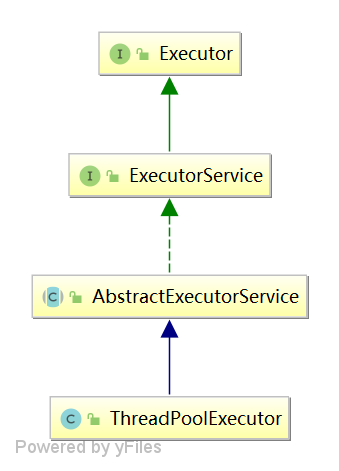区别
先看ThreadPoolExecutor的继承关系图

1.定义上
void execute(Runnable command)是Executor接口中定义的方法
<T> Future<T> submit(Callable<T> task)和<T> Future<T> submit(Runnable task, T result)是ExecutorService中定义的方法。
2.使用区别
execute()一般用来执行没有返回值的任务,而submit()用来执行需要返回值的任务
3.异常处理
execute()在执行过程中出现异常,如果任务没有定义对异常的处理,则会默认抛出。而submit()执行时发生异常,底层会对异常进行捕获并记录。只有使用返回值Future的get()方法时才会抛出记录的异常。
分析原因
execute(Runnable r)底层是调用了Runnable的run()方法,没有捕获异常。
submit()比较复杂,它首先将task封装成一个FutureTask<V>对象,然后对这个对象调用execute(Runnable r):
public Future<?> submit(Runnable task) {
if (task == null) throw new NullPointerException();
RunnableFuture<Void> ftask = newTaskFor(task, null);
execute(ftask);
return ftask;
}
/**
* @throws RejectedExecutionException {@inheritDoc}
* @throws NullPointerException {@inheritDoc}
*/
public <T> Future<T> submit(Runnable task, T result) {
if (task == null) throw new NullPointerException();
RunnableFuture<T> ftask = newTaskFor(task, result);
execute(ftask);
return ftask;
}
/**
* @throws RejectedExecutionException {@inheritDoc}
* @throws NullPointerException {@inheritDoc}
*/
public <T> Future<T> submit(Callable<T> task) {
if (task == null) throw new NullPointerException();
RunnableFuture<T> ftask = newTaskFor(task);
execute(ftask);
return ftask;
}
在上面的代码中,可以看到submit()有三个重载方法,submit()也可以接收Runnable类型的参数,重点对Callable类型的submit()分析。
实际上,Executors类中使用了适配器模式,用Callable适配Runnable,用call()包装了run()。
在submit()内部,调用了newTaskFor(task),返回了一个RunnableFuture<T>类型的引用ftask,接着调用了execute(ftask),并且最终返回了ftask。
注意:
最终返回了FutureTask<V>对象,也就是说,将任务和任务的结果都封装在了这个对象中。
一步步分析:
-
newTaskFor(task)调用了FutureTask的构造方法 protected <T> RunnableFuture<T> newTaskFor(Callable<T> callable) { return new FutureTask<T>(callable); } public FutureTask(Callable<V> callable) { if (callable == null) throw new NullPointerException(); this.callable = callable; this.state = NEW; // ensure visibility of callable }可以看到,callable被赋值给在了FutureTask里面的一个叫
callable的属性。 -
newTaskFor()返回的是RunnableFuture
类型引用,这是个接口且FutureTask继承自这个接口。 public interface RunnableFuture<V> extends Runnable, Future<V> { /** * Sets this Future to the result of its computation * unless it has been cancelled. */ void run(); }Runnable方法中已经声明了一个run(),这里为什么还要定义一个run(),原因可能仅仅是作者为了提醒使用者。 而FutureTask实现了RunnableFuture接口,这意味着它内部一定定义了run()方法。
-
前面提到execute()的原理是调用run()方法且没有对异常进行默认捕获,而submit()内部是调用execute(Ftask),所以submit()中对异常处理的关键之处就在
FutureTask<V>对run()方法的定义。public void run() { if (state != NEW || !UNSAFE.compareAndSwapObject(this, runnerOffset, null, Thread.currentThread())) return; try { Callable<V> c = callable; if (c != null && state == NEW) { V result; boolean ran; try { result = c.call(); ran = true; } catch (Throwable ex) { result = null; ran = false; setException(ex); } if (ran) set(result); } } finally { // runner must be non-null until state is settled to // prevent concurrent calls to run() runner = null; // state must be re-read after nulling runner to prevent // leaked interrupts int s = state; if (s >= INTERRUPTING) handlePossibleCancellationInterrupt(s); } }很明显,这里定义的run()方法调用了callable属性的call()方法。 关键之处:对异常进行了捕获并记录了,可以看到对捕获的异常调用了setException(ex),不妨看一下这个方法的源码:
protected void setException(Throwable t) { if (UNSAFE.compareAndSwapInt(this, stateOffset, NEW, COMPLETING)) { outcome = t; UNSAFE.putOrderedInt(this, stateOffset, EXCEPTIONAL); // final state finishCompletion(); } }可以看到,这个方法的内部将异常对象赋值给一个名为outcome的属性,它是个Object类型的属性
/** The result to return or exception to throw from get() */ private Object outcome; // non-volatile, protected by state reads/writes这个outcome的作用就是存储从get()方法返回的结果或者抛出的异常。 从这里可以了解到,假设任务抛出了异常,异常会被捕获并用outcome维护这个异常对象,等到调用get()才能得到这个异常对象。
OK,让我们看一下get()方法做了什么:
public V get() throws InterruptedException, ExecutionException { int s = state; if (s <= COMPLETING) s = awaitDone(false, 0L); return report(s); }get()调用了一个report()方法,它是私有的。
private V report(int s) throws ExecutionException { Object x = outcome; if (s == NORMAL) return (V)x; if (s >= CANCELLED) throw new CancellationException(); throw new ExecutionException((Throwable)x); }到这里,我们的分析已经豁然开朗了!
- 当任务没有异常,report()会返回outcome并强转为泛型类型。
- 当任务出现异常,会将异常抛出!
结论
submit()执行的任务如果没有对异常进行处理,则会被捕获并封装到结果对象即FutureTask<V>类型的对象中,只有在调用它的get()方法时才会抛出。
如果使用submit()执行任务没有对异常进行处理或者没有调用结果对象的get()方法,很难找到任务中发生了什么异常。
建议:对于没有返回值的任务,使用execute()执行。
联系
其实经过对submit()和execute()的区别的分析,可以知道它们的联系就是submit()方法内部调用了execute()。